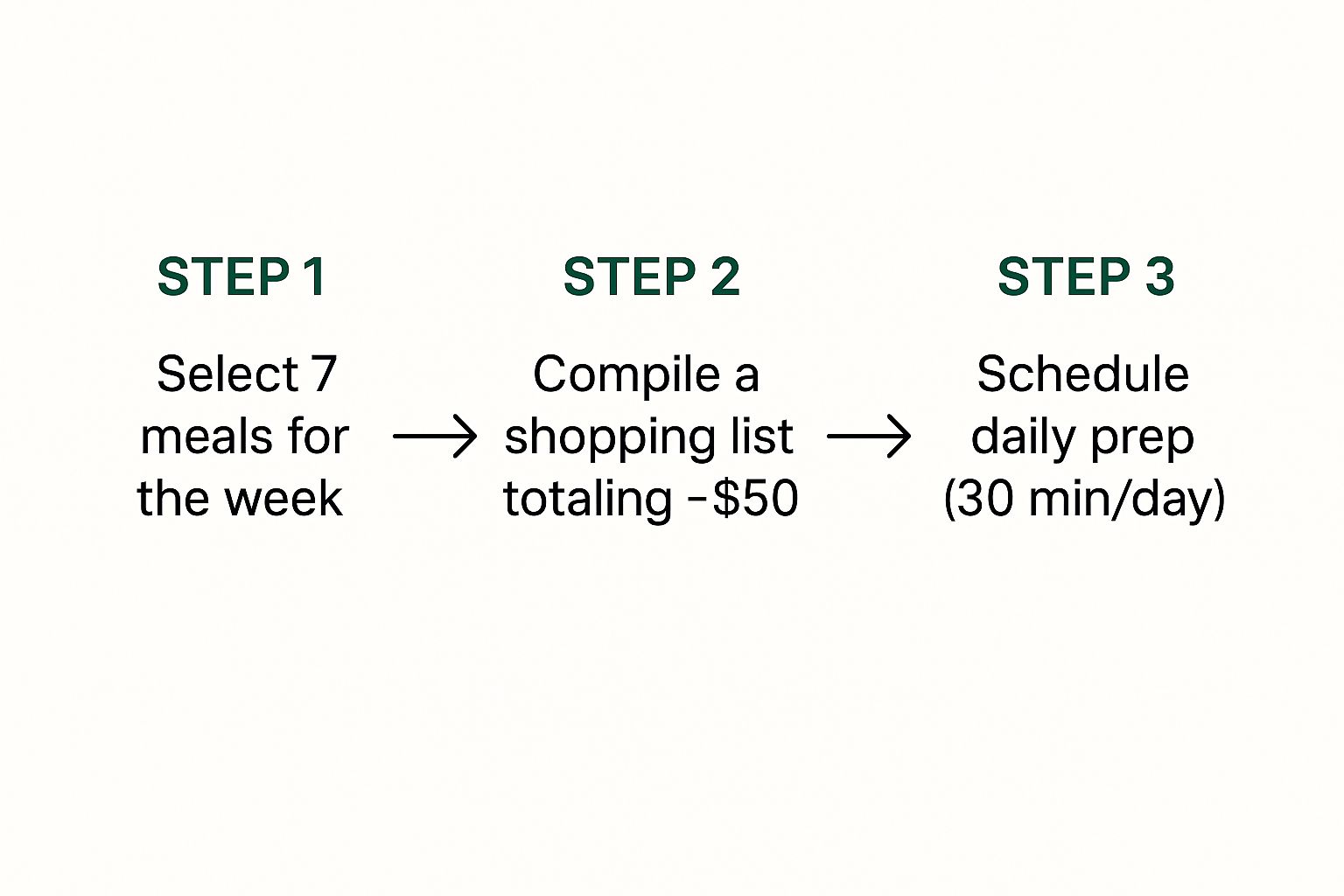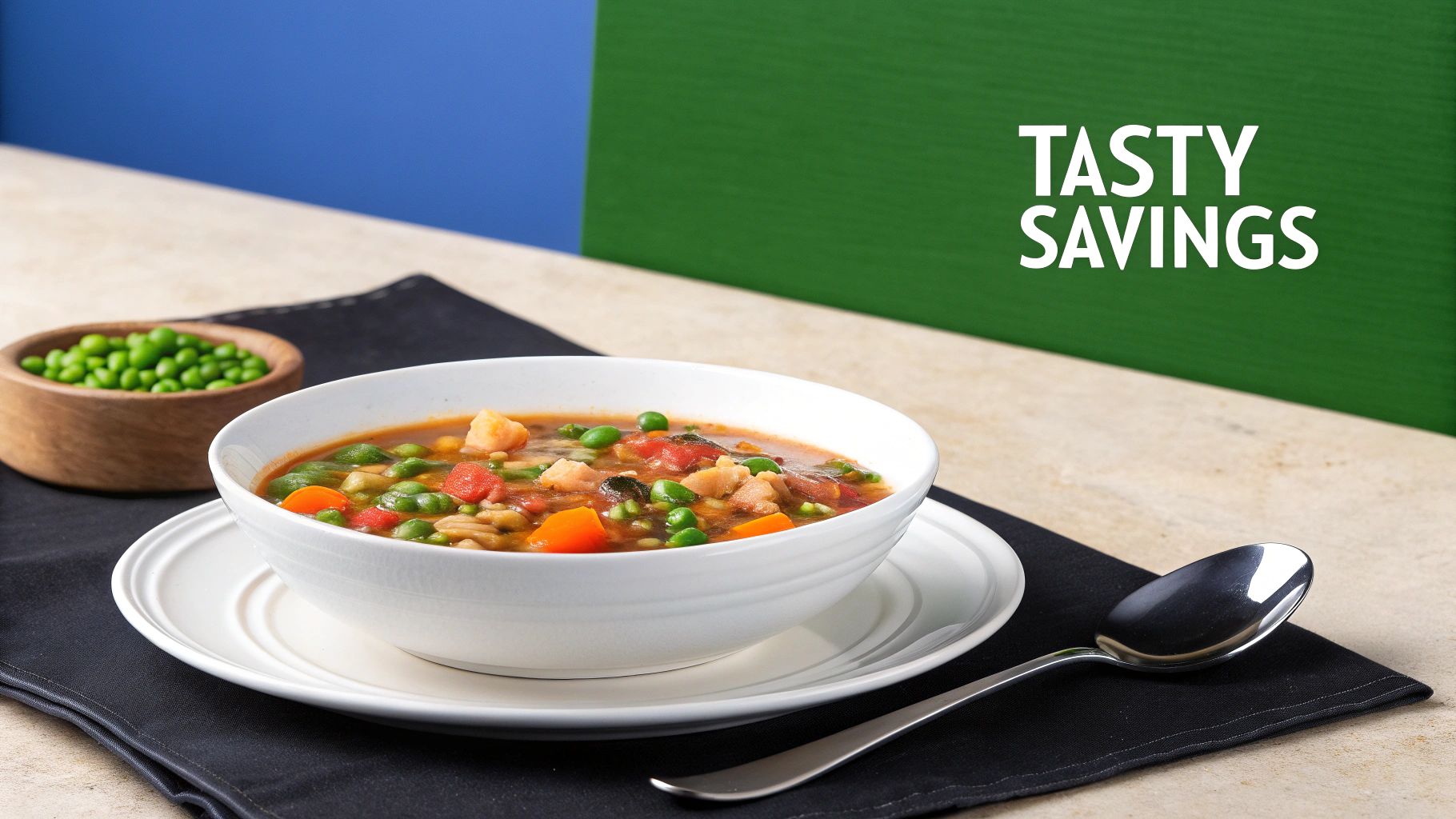Your Guide to a Budget Friendly Meal Plan That Works
Tired of high grocery bills? Our guide to a budget friendly meal plan helps you eat well, save money, and simplify your life with smart, actionable tips.
Love This Article?
Get personalized meal plans with recipes like this, automatically matched to your nutrition targets.

Your Guide to a Budget Friendly Meal Plan That Works
Think of a budget-friendly meal plan as your secret weapon against those ever-climbing grocery bills. It's really just a simple, smart way to decide what you'll eat ahead of time. The result? You buy only what you need and, just as importantly, you actually use everything you buy. Making this one change—from just winging it at the store to planning with purpose—is the fastest way to get a grip on your spending without giving up on great food.
Ditch Grocery Chaos and Start Saving Today
Ever get to the checkout line, see the total, and feel that gut-punch of sticker shock? Yeah, you're not alone. The weekly grocery run can feel less like an errand and more like a financial ambush, where every impulse buy and forgotten ingredient drains your bank account. This is exactly where a flexible, budget-friendly meal plan steps in to save the day (and your wallet).
And let's be clear: this isn't about sentencing yourself to a week of boring, sad meals. Not even close. It’s about taking back control and telling your money where to go, instead of wondering where it went. We’re going to walk through a simple system that gets you out of that cycle of chaotic, last-minute "what's for dinner?!" scrambles and into a calmer, more intentional way of eating.
This is more important now than ever. Let's face it, food prices are a huge part of everyone's budget, and they aren't coming down anytime soon. The USDA predicts that grocery prices will climb another 2.2% this year, with restaurant meals jumping by 3.9%. A smart plan helps you roll with these punches without breaking a sweat.
The Real Cost of Not Planning
Let’s paint a picture of two very different weeks. First, there's the "No-Plan" week. You know this one: a few "quick" trips to the store after work, a couple of expensive takeout nights, and that sad, wilted bag of spinach you never got around to using. Then there's the "Smart-Plan" week—one focused shopping trip, delicious home-cooked meals, and a much happier bank account at the end of it.
The difference is staggering, not just for your finances but for your sanity. Imagine cruising through your week knowing exactly what's for dinner every night, with all the ingredients already in the fridge. That's the kind of freedom a little planning can buy you.
A meal plan isn’t about restriction; it's about liberation. You're freeing up money, time, and the mental energy you used to waste stressing about dinner.
To really see what this looks like in black and white, let's compare the real-world impact of these two approaches. The numbers don't lie, and they often expose a surprising amount of cash that was getting lost to convenience and disorganization.
No Plan vs Smart Plan: A Weekly Cost Snapshot
Here's a side-by-side look that breaks down just how much you stand to gain by trading chaos for a bit of structure.
| Metric | The 'No-Plan' Approach | The Smart Plan Approach |
| Weekly Food Cost | $200 - $300+ | $75 - $125 |
| Grocery Trips | 3-5 trips, plus impulse buys | 1 focused trip with a list |
| Food Waste | High (wilted produce, old leftovers) | Minimal (ingredients are planned) |
| Stress Level | High (daily "what's for dinner?" panic) | Low (meals are planned and prepped) |
| Time Spent | 4-6 hours (multiple trips, daily decisions) | 2-3 hours (planning and one trip) |
See the difference? By adopting a smart plan, you're doing so much more than just cutting costs—you're building a more organized, less stressful life. You’ll eat better, waste less, and reclaim your evenings from the tyranny of the last-minute meal scramble. It's all about eating smarter, not cheaper, and saving hundreds of dollars a month without sacrificing the food you love.
Create a Food Budget You Can Actually Keep

Let's talk about money. But don't worry, you can put the complicated spreadsheets and soul-crushing math away. The secret to a food budget that actually works isn't about complex formulas; it's about getting brutally honest about where your cash is really going. The first step toward a meal plan that's kind to your wallet is a little reality check.
For just one week, track every single dollar you spend on food. Seriously, everything. Don't change a thing about your habits—just be a fly on the wall of your own wallet. Log the big grocery haul, that mid-week dash for milk, the "I'm too tired to cook" takeout, and yes, even that fancy coffee you grabbed on Tuesday. Now, total it all up. Surprised? Most people are. This number isn't here to shame you; it's your starting line.
Find Your Magic Number
Okay, you've got your baseline number. Now you can set a goal that isn't a total fantasy. If you discovered you spent $250 last week, trying to slash it to $100 overnight is a recipe for disaster (and a hangry breakdown). Instead, aim for a small, manageable trim—think 15-20%. This might land your new weekly budget closer to $200. Success is what builds momentum, not drastic, painful cuts.
A fantastic trick to make this stick is to steal the "Pay Yourself First" method and apply it to groceries. As soon as you get paid, move your food money. You could transfer it to a separate account, but my personal favorite is the old-school cash envelope system. There's something powerful about seeing the cash. When the envelope is empty, the spending stops. Simple as that.
A budget isn't a restrictive cage. It's a tool that gives you permission to spend intentionally on the food you love. It flips the script from "I can't afford that" to "I'm choosing to spend my money here instead."
This simple act of earmarking your grocery fund prevents it from being mysteriously absorbed by other bills before you even get to the store.
Building in Wiggle Room
Let's be real: a budget that’s too strict is doomed to fail. Life happens! You're going to want pizza on a Friday night, or you'll get inspired to try a new recipe that requires a special ingredient. You have to plan for it. A smart budget has a built-in buffer for these moments.
Here's how I like to break it down:
- Core Grocery Budget: This is the money for your planned meals and staples for the week (e.g., $150).
- Flex Fund: A smaller, separate pot of cash for life's delicious little curveballs (e.g., $30). This is your guilt-free fund for spontaneous takeout, a coffee with a friend, or that fancy block of parmesan you've been eyeing.
- Stock-Up Savings: This is my secret weapon. Any money left over at the end of the week (maybe $20) goes into this pot. You can use it to buy pantry items in bulk when they go on a deep discount, which saves you a ton of money in the long run.
This structure gives you the freedom to live a little without derailing your entire plan. It acknowledges that a good budget has to be flexible to survive in the real world. By giving every dollar a job—even the "fun" dollars—you transform your budget from a chore into your kitchen's most valuable tool.
Become a Pro at Finding Affordable Ingredients
Let's be honest, the real secret to a budget-friendly meal plan isn't some complex spreadsheet or a magical couponing binder. It’s all about what you put in your shopping cart. The trick is to become a value detective in the grocery store aisles—and trust me, it’s a lot more satisfying than it sounds.
You need to start seeing ingredients not just for what they are, but for what they could be. Think of certain foods as your kitchen's utility players. These are the versatile, low-cost staples that form the backbone of a shocking number of meals. A simple bag of potatoes isn't just a bag of potatoes; it's crispy roasted wedges one night, a creamy soup base the next, and the fluffy topping for a shepherd's pie on the weekend. That's the mindset.
This little visual really drives home how the whole process fits together.

It’s clear that putting in a bit of planning and prep time upfront saves a ton of money and stress throughout the week.
Spotting True Bargains
One of the oldest tricks in the grocery store book is the sale sign. A real bargain isn't just about the bright yellow tag; it’s all about the unit price. Always, always look at that tiny number on the shelf that shows you the cost per ounce or per pound. You’d be surprised how often the larger, non-sale package is actually cheaper per unit than the smaller, flashy "special."
And please, don't overlook store brands. For staples like canned tomatoes, flour, pasta, and spices, the generic version is often made in the exact same facility as the big-name product. The only difference is the fancy label you're paying for. Making the switch can easily save you 20-30% without you ever noticing a dip in quality.
Here's the key takeaway: The goal isn’t just to buy cheap food. It's to buy smart food. An ingredient you can use in three different recipes this week is infinitely more valuable than a niche item you'll use once and then forget about in the back of your fridge.
When you focus on versatility, you’re also fighting food waste—which is literally the same as throwing money in the garbage.
Your Top 10 Budget-Friendly All-Stars
Ready to build your shopping list? Here are 10 powerhouse ingredients that will stretch your dollars and your culinary creativity. Think of these as your new best friends.
- Lentils: The undisputed champion of cheap protein. Perfect for hearty soups, veggie burgers, or even as a substitute for ground meat in a bolognese.
- Canned Tomatoes: The foundation for countless sauces, chilis, stews, and skillet dinners. A must-have.
- Eggs: Is there a more perfect food? They're a fantastic source of protein for breakfast, lunch, or a quick "brinner" (breakfast for dinner).
- Onions & Garlic: The flavor base for pretty much every savory dish on the planet. Non-negotiable.
- Potatoes: Mash 'em, roast 'em, fry 'em, stick 'em in a stew. Their potential is nearly limitless.
- Cabbage: Don't sleep on cabbage! You can sauté it, shred it for slaw, or add it to stir-fries for incredible bulk and crunch.
- Frozen Spinach: A nutritional powerhouse you can toss into smoothies, pasta dishes, and casseroles. It's often cheaper than fresh and lasts for ages.
- Pasta: The classic budget meal starter for a reason. Combine with different sauces and veggies for endless variety.
- Chicken Thighs or Drumsticks: Way more flavorful and affordable than chicken breasts. They are phenomenal when roasted, braised, or shredded for tacos.
- Canned Tuna or Salmon: Your go-to for lightning-fast sandwiches, protein-packed salads, and comforting pasta bakes.
Having these items on hand gives you a massive head start. You'll always have the building blocks for a quick, cheap, and delicious meal, transforming "what's for dinner?" from a question of stress into a fun challenge.
Master Batch Cooking Without Losing Your Weekend

Alright, this is where all that smart grocery shopping and planning really starts to shine. When most people hear "meal prep," they picture a full Sunday spent locked in the kitchen, packing endless, identical containers of chicken, broccoli, and rice. Let's just agree to throw that sad, boring image straight into the bin.
The truth is, effective meal prep isn't about creating a food-based prison for your week. It’s about building a personal arsenal of delicious, ready-to-go components. The game-changing strategy here is called component prep. Instead of cooking five complete, separate meals, you cook individual ingredients. Think of it as setting up your very own healthy "fast food" bar right in your fridge. This approach is the secret to a flexible, budget-friendly week because you can pivot based on what you're actually in the mood for, using what you've already prepped.
The Component Prep Method in Action
So what does this look like in the real world? Picture this: you block out just an hour or two on Sunday. No complex, multi-step recipes. You're just making simple, versatile building blocks.
- Proteins: Get a big batch of chicken going in the slow cooker to shred, bake some seasoned chicken thighs, or hard-boil a dozen eggs. Easy.
- Grains: Make a generous pot of quinoa, brown rice, or even pasta. These are your foundations for hot and cold meals all week.
- Vegetables: Toss a sheet pan of your favorite veggies—bell peppers, onions, zucchini—in the oven to roast. While that’s happening, wash and chop your salad greens so they’re ready for action.
- Sauces: Whip up a quick vinaigrette or a simple, all-purpose tomato sauce.
Now, watch the magic unfold during the week. That shredded chicken? It becomes killer chicken tacos on Monday. On Tuesday, you throw it over those pre-chopped greens with some roasted veggies and your homemade vinaigrette. By Thursday, you can stir the last of it into that big pot of rice with some frozen peas for a ridiculously fast fried rice. That’s three completely different meals from one simple prep session.
The goal of meal prep isn't to force yourself to eat the same boring thing all week. It's to make cooking a delicious, spontaneous meal so ridiculously easy that ordering takeout never even crosses your mind.
This is how you sidestep that dreaded meal-prep burnout and keep your dinners interesting.
Genius Storage and Freezing Tips
Don’t underestimate the power of your storage game—it’s just as important as your cooking strategy. Good containers are an investment that pays for itself. I’m a huge fan of clear, glass containers because you can see what’s inside at a glance, which helps put an end to those "mystery container" science experiments that lead to food waste.
And let’s not forget your freezer. It’s your absolute best friend for making your prepped food go the distance. Making the most of every ingredient might seem small, but it's a huge deal. This mindset is critical on a global scale, too. For perspective, the World Food Programme recently helped 124.4 million people, a stark reminder of why we need to be smarter about our food and cut down on waste. You can read more about these global food security efforts and see how our small efficiencies can be part of a much bigger picture.
Of course, not everything freezes well. Here’s a quick cheat sheet based on my own trial and error:
| Freezes Beautifully | Avoid Freezing |
| Soups, stews, and chilis | Cream-based sauces |
| Cooked grains (rice, quinoa) | Salads with dressing |
| Shredded or cooked meats | Raw potatoes |
| Most baked goods (muffins, bread) | Fried foods (they just get soggy) |
| Blanched vegetables | Dairy-heavy dishes (like yogurt) |
Once you get the hang of component prep and smart storage, your kitchen transforms. It stops being a place of daily chores and becomes a hub for quick, creative, and tasty meals. You’ll get hours of your life back, slash your food waste, and stick to your budget without ever feeling like you’re missing out.
Bring in Your Digital Sous Chef: The Meal Planning App
Alright, you've got the hang of choosing wallet-friendly ingredients and you're a batch-cooking pro. Now, it's time to bring your meal plan into the 21st century with a little help from technology. Meal planning apps have evolved way beyond simple digital recipe boxes. Today, they're more like a personal assistant for your kitchen, ready to save you a ton of time, money, and headaches.
Think about it. You wouldn’t try to manage your finances with just a notebook and a prayer, would you? So why tackle the complex logistics of feeding yourself or your family—the planning, shopping, and budgeting—without a tool built for the job? These apps can take the most dreaded parts of meal planning and make them almost ridiculously easy.
It's no surprise that these digital helpers are taking off. The global meal planning app market is already a USD 2.8 billion industry and is projected to hit USD 7.2 billion by 2033. That boom tells you one thing: people are desperate for smarter ways to handle their busy lives and tight budgets. You can dig into the trends fueling the meal planning app explosion to see just why they've become such a lifeline for so many households.
Let AI Do the Annoying Stuff
This is where the real magic happens. The best modern apps, like Meal Flow AI, are packed with smarts. One of my absolute favorite features is its ability to create recipes from the random stuff you already have in your kitchen. Just tell it you’ve got some chicken thighs, a wilting bag of spinach, and a can of tomatoes, and poof! It spits out a bunch of ideas. This single trick is a game-changer for cutting down on food waste and avoiding that panicked, last-minute trip to the store.
This isn’t about taking the joy out of cooking. It’s about letting a clever system handle the grunt work so you can get back to the fun parts.
The biggest win with an app is that it kills the "what's for dinner?" decision fatigue. It frees up your mental energy for stuff that actually matters, like enjoying your evening instead of stressing over a grocery list.
With that kind of backup, sticking to your meal plan becomes a whole lot easier, which means less food—and money—ends up in the trash.
Features That Put Money Back in Your Pocket
Beyond just finding recipes, these apps are armed with a suite of tools designed to help you hit your financial goals. Can you imagine a world where your meal plan instantly generates a perfectly organized shopping list? It's real, and it's fantastic.
Here are a few of the game-changing features to look for:
- Automated Shopping Lists: Say goodbye to scribbling on the back of an envelope. As you pick your meals, the app builds your list, which you can often send straight to a service like Instacart.
- Budget Tracking: Many apps let you plug in a weekly food budget and will show you a running total as you add items. It's a simple way to see if you're on track before you even get to the store.
- Nutrition Info: Curious about the calories or protein in your weekly plan? Most apps show you the nutritional breakdown at a glance, helping you balance your health goals with your budget.
- Pantry Inventory: This is a classic budget-killer: buying something you already have. A digital pantry tracker helps you keep tabs on what's on hand so you don't buy your third jar of paprika by mistake.
When you use these tools, you're not just planning meals anymore. You're building a smart, efficient system for managing your entire household's food economy. It's the tech-savvy upgrade that turns your simple meal plan into a dynamic, intelligent partner that helps you win the week, every single week.
Got Questions About Budget Meal Planning? We've Got Answers.

Jumping into a new routine, especially one involving your food and your wallet, can feel like you're about to assemble some wildly complicated piece of furniture with no instructions. It's completely normal for a few questions to bubble up before you're ready to dive in. Trust me, we’ve heard them all.
So, let's tackle some of the biggest hurdles right now. Think of this as your personal FAQ, designed to give you the confidence to start saving money and eating spectacularly well. These are the real-world answers you need to make your budget friendly meal plan a huge success.
"I'm a Total Beginner. Where Do I Even Start?"
Feeling overwhelmed is the #1 reason people give up on meal planning before they even start. So, let's keep it ridiculously simple. Your first mission, should you choose to accept it, is not to map out 30 days of complex gourmet meals. Just focus on three. That's it. Three dinners for the week ahead.
Grab your local grocery store's weekly flyer (or pull it up online). What's on sale? If chicken thighs are practically a steal, plan a meal around them. If potatoes are dirt cheap, maybe it’s time for a hearty potato soup. Building your first few plans around what's on sale is the quickest path to instant savings, and nothing motivates like seeing that grocery bill shrink.
"How Do I Keep From Getting Bored?"
This is the big one, isn't it? The specter of eating the same bland chicken and rice from a sad little container for five days straight is enough to scare anyone off. The trick is to stop thinking about prepping full meals and start thinking about prepping versatile components.
The secret to variety isn't a thousand different recipes; it's a dozen smart components you can mix and match in new ways every day.
For instance, instead of making five identical bowls, try this:
- Bake a big batch of seasoned chicken breast.
- Cook up a large pot of quinoa.
- Roast a sheet pan of colorful, mixed vegetables.
Suddenly, you have the building blocks for chicken salads, grain bowls, quick wraps, or even a stir-fry. Also, build in some freedom! Schedule a "leftover night" or a "freestyle night" where anything goes. That little bit of planned flexibility is the key to making this habit stick.
"What Do I Do About Picky Eaters?"
Ah, the ultimate challenge. Planning meals for a family with wildly different tastes can feel like a diplomatic nightmare. The solution? Deconstruct your meals. Instead of serving a finished, one-size-fits-all dish, set up a "build-your-own" station. The classic taco bar is a classic for a reason—it just works!
You lay out the core parts: a protein (like seasoned ground turkey or black beans), tortillas or shells, and a bunch of toppings like shredded lettuce, cheese, salsa, and sour cream. Everyone gets to assemble a plate they're actually excited to eat. This gives your family a sense of control, dials down the dinner-table drama, and—best of all—slashes food waste from uneaten meals. It’s a massive win for your budget and your sanity.
---
Ready to make your budget-friendly meal plan even easier? Let Meal Flow AI do the heavy lifting. Our smart platform generates personalized meal plans based on your needs and automatically creates your shopping list for you. Stop stressing and start cooking. Discover how Meal Flow AI can simplify your life today!